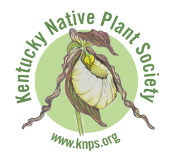Jeff Nelson, KNPS President
As I write this, I am looking out at our woods in southwest McCracken Co., covered in 4″ of fresh snow. I have always loved to walk in the woods in the winter. The deciduous trees have lost most of their leaves and you can see their form and structure more clearly. Most of the herbaceous species have gone dormant but dried stalks with seed heads dot the woods. And if one looks, one will also see many species of native plants still photosynthesizing away throughout any woodland in Kentucky.
There are several species of native plants that take advantage of the extra sunlight reaching the woodland floor to photosynthesize throughout the winter. One of my favorite of these species is cutleaf grapefern (Sceptridium dissectum), which grows widely in our woods. Grapefern is also known as bronze fern for the color the sterile fronds turn after a hard frost or freeze. The bronze color, caused by anthocyanins in the sterile fronds, helps the fern withstand harsh winter conditions and the extra sunlight by reducing the amount of sunlight absorbed, preventing excessive water loss, and other cell damage. Grapefern will photosynthesize throughout the winter, with the fronds usually senescing in the spring. The sterile fronds will reemerge in the summer, with the fertile fronds appearing in late summer.
What is your favorite winter photosynthesizing native? Perhaps one of the other ferns, such as Christmas fern (Polystichum acrostichoides) or ebony spleenwort (Asplenium platyneuron)? Maybe one of the mosses (Bryophyta), many which are green and growing through the entire winter. Native orchids such as cranefly (Tipularia discolor) and puttyroot (Aplectrum hyemale) are low growing flashes of green on the brown forest floor and are always fun to come across. Regardless of your favorite species, getting into natural areas this time of year can bring joy in seeing the resilience and beauty of our native plant communities.
2024 was another good year for KNPS. The year began in February with our Fourth Annual Kentucky Botanical Symposium. In April nearly 200 members and friends enjoyed KNPS’s 35th Wildflower Weekend, at Natural Bridge SRP! Wildflower walks and hikes are the defining activities of every Wildflower Weekend, but in 2024 we also included hikes about fire ecology, geology, birds, herps, butterflies, pollinators, reptiles and more! Beginning at noon on Friday and running through the end of the day on Saturday, we enjoyed a record number of 25 flora and fauna walks. The week before Wildflower Weekend was another successful statewide Botany Blitz. Observers across the Commonwealth recorded over 3,000 observations of 571 species of native plants, including rare species. In the summer we conducted several field trips to natural areas from one end of the state to the other. From Hi Lewis Pine Barrens SNP in Harlan County to Pine Creek Barrens in Bullitt County and Ballard WMA in Ballard County, KNPS members were able to explore the native plants in uncommon ecosystems of our state. KNPS activities in 2024 came to a close with our annual Fall Meeting at Bernheim Aboretum.

All of KNPS’s activities are planned, organized, and executed by dedicated volunteers. Dozens of folks volunteer hundreds of hours each year to make our events the exceptional educational and fellowship opportunities they are. I thank each and every one of the volunteers for their efforts for the Society and the native plants of Kentucky. Last, but certainly not least, I want to thank all you, our members and friends, for your participation in events, for your contributions to the Society, and for your love of the native plants and plant communities of where ever you call home. Thank you!
The Board is planning many more educational and conservation activities in 2025. Starting with the Wildflower Week 2025 Botany Blitz on April 6, leading up to Wildflower Weekend 2025 at Carter Caves SRP. Be sure to read the post in this month’s blog, Save the Date! KNPS Wildflower Weekend 2025 – April 11-13, 2025. Also in 2025 look for several field trips, organized by our new Field Trip Coordinator, Alan Abbott. Planning has already begun for the Fall Meeting and the virtual Kentucky Botanical Symposium, both coming up this fall.
Thank you again and I hope you can get out and enjoy some time in the natural areas near to you this winter. And if you have any comments or thoughts or would like to become a volunteer or if you just want to vent, send me an email at president@knps.org.
A native of California, Jeff, his wife Liz, and their son Aaron, moved to McCracken Co., Kentucky, in 1987. After building their house on 10 acres, the family has spent the last 30+ years restoring the property from farmland to a native woodland. As a lifelong amateur naturalist, Jeff loves exploring Kentucky and learning about the rich diversity of the Commonwealth’s many ecosystems. He has been a member of the KNPS since the early 1990s and on the Board since 2017. He has been president since 2020. And he really does love to walk in the winter woods.



